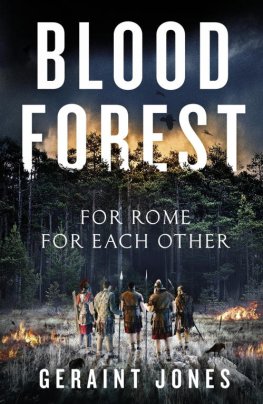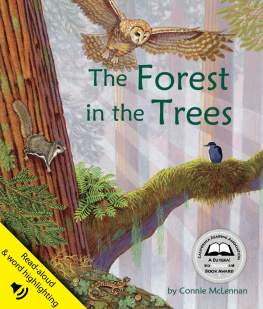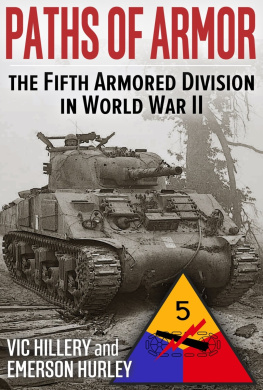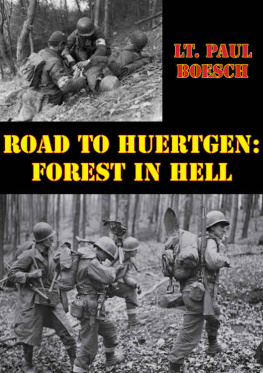Gerald Astor - The Bloody Forest
Here you can read online Gerald Astor - The Bloody Forest full text of the book (entire story) in english for free. Download pdf and epub, get meaning, cover and reviews about this ebook. year: 2000, publisher: Presidio Press, genre: History. Description of the work, (preface) as well as reviews are available. Best literature library LitArk.com created for fans of good reading and offers a wide selection of genres:
Romance novel
Science fiction
Adventure
Detective
Science
History
Home and family
Prose
Art
Politics
Computer
Non-fiction
Religion
Business
Children
Humor
Choose a favorite category and find really read worthwhile books. Enjoy immersion in the world of imagination, feel the emotions of the characters or learn something new for yourself, make an fascinating discovery.

- Book:The Bloody Forest
- Author:
- Publisher:Presidio Press
- Genre:
- Year:2000
- Rating:3 / 5
- Favourites:Add to favourites
- Your mark:
- 60
- 1
- 2
- 3
- 4
- 5
The Bloody Forest: summary, description and annotation
We offer to read an annotation, description, summary or preface (depends on what the author of the book "The Bloody Forest" wrote himself). If you haven't found the necessary information about the book — write in the comments, we will try to find it.
The Bloody Forest — read online for free the complete book (whole text) full work
Below is the text of the book, divided by pages. System saving the place of the last page read, allows you to conveniently read the book "The Bloody Forest" online for free, without having to search again every time where you left off. Put a bookmark, and you can go to the page where you finished reading at any time.
Font size:
Interval:
Bookmark:

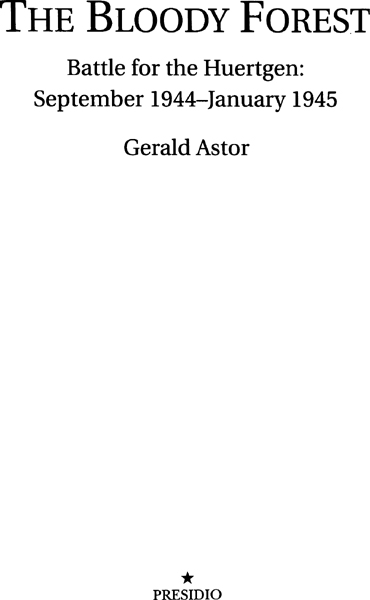
1:
2:
3:
4:
5:
6:
7:
8:
9:
10:
11:
12:
13:
14:
15:
16:
17:
I am indebted to all of those veterans of the Huertgen Forest campaign who gave me their time and their recollections so freely. Their names are found in the section Roll Call. I would also like to thank Colonels Tom Cross, USA Ret., and Richard Cross, USA Ret., for their efforts to afford me access to the personal papers and for their recollections of their father, Col. Thomas J. Cross, who commanded a regiment in the 8th Division. Benjamin Mabry was kind enough to give me access to tapes recorded by his late father, George L. Mabry, Jr., a 4th Division Battalion CO, as well as some personal papers. John Swearingen, who served under Mabry, also answered questions about himself and his commander.
Dorothy Chernitsky, as she has in the past, allowed me access to the sources for her book Voices from the Foxholes. John Marshall not only supplied me with his memoir and the details of his time in the forest, but also put me in touch with a number of his comrades from the 707th Tank Battalion. Al Burghardt, who fought with the 110th Infantry, responded to questions and sent me portions of his personal account of his military career.
Colonel Henry Red Phillips provided me with his memories and furnished names and addresses for others in the 9th Infantry Division. Chester Jordan, from the same organization, passed along his manuscript Bull Sessions and also freely answered questions. Ralph Hendrickson supplied a wealth of information on the 5th Armored Division. Donald Faulkner shared his memories and sent me clippings and reports that went beyond his experience with the 22d Infantry Regiment. Clifford Eames gave me relevant portions of his 800-page account of a 1st Division rifleman.
Norris Maxwell, one of the people who suggested I write about the Huertgen campaign, spoke frankly of his own difficulties as a member of the 121st Infantry Regiment and put me in touch with Stephen Roddy Wofford.
The 1st Infantry Division Association printed a notice in its Bridgehead Sentinel of my interest in hearing from men who engaged the enemy along the Siegfried Line. The 4th Infantry Division Association performed a similar service in its Ivy Leaves. Bill Parsons, editor of the 78th Division Associations The Flash, showered me with back issues, which enabled me to find memoirs of veterans from the campaign. Reverend Will Cook, from the 5th Armored Division Association, passed along copies of the Victory Division News. Bob Babcock gave me a copy of History of the 22d Infantry Regiment in World War II and newsletters issued by the 22d Infantry Regiment Society. Sidney A. Salomon supplied his monograph on the 2d Ranger Battalion, which covers the period of 14 November to 10 December 1944.
William Pea of the 28th Division not only gave me permission to quote from his book, As Far as Schleiden, but also answered my questions and furnished me with copies of letters from the German soldier Hubert Gees. In the same vein, Harry Kemp, from the 28th, also contributed valued information through his book, The Regiment. The 39th Infantrys Donald Lavender allowed me to quote from his monograph Nudge Blue: A Riflemans Chronicle of World War II Experience.
Richard Blackburn loaned me the histories of the 13th, 28th, and 121st Regiments, among other items. Edward G. Miller was a gracious source through his book A Dark and Bloody Ground. George Wilson gave me a copy of his personal history, If You Survive. Albert Trosdorf of Merode, Germany, was kind enough to send me a copy of the memoirs of tanker Alvin Bulau. Dr. David Keough, with the U.S. Army Military History Library at Carlisle Barracks, Pennsylvania, pointed out relevant material in the archives.
Quotations from If You Survive by George Wilson (New York: Ballantine Books, 1987) are included by permission.
I n the course of research and interviews while writing a series of books on World War II, I became increasingly aware of the campaign for the Huertgen Forest. While survivors of other battles sometimes criticized the strategy and the orders they were given, there was a depth of anger about the Huertgen that surpassed anything I had encountered elsewhere. The unhappiness with what occurred and the absence of much objective coverage in the memoirs of those in the top command slots convinced me to produce this history.
As I have reiterated in all of my books, which rely heavily on oral or eyewitness reports, there are always the dangers of flawed memory, limited vantage points, and the possibility of self-interest in such accounts. But the almost universal condemnation of their superiors critical decisions by individuals who were under fire in that green hell offers a cautionary note on the accuracy and the truths of histories that draw from the official documents and the personal papers of the likes of Dwight Eisenhower, Omar Bradley, Courtney Hodges (who apparently left little in the way of records), J. Lawton Collins and others in similar positions.
On a personal note, the accounts of those who participated in the Huertgen combat triggered memories of my own service during World War II. I was an infantry replacement, and although I was fortunate to have spent my time in the European Theater guarding prisoners and hauling ammunition, I now realize how poorly I was trained, a condition that unfortunately pertained to many of those committed in the Huertgen and elsewhere.
I spent a great deal of my basic training period learning how to salute and perform close order drill. I had ample practice with an M1 rifle but never touched a BAR or the standard .30-caliber machine guns. When we practiced with a truck-mounted .50-caliber machine gun to shoot at a radio-controlled model airplane, we were not allowed to use tracers, making the aiming exercises useless. (A drone was too expensive to risk having someone shoot it down.)
I was schooled as an antitank crewman on a 57mm cannon, a weapon that was obsolete two years before I went on active duty in September 1944. At that, we had only a few days of practice with the piece. As infantry replacements, we were expected on occasion to be able to serve as riflemen. I never went through any training in house-to-house combat, which frequently characterized the efforts to capture villages in the Huertgen. I had no instruction for dealing with a pillbox. Nor did I, or anyone else I talked to, learn how to handle ones self when fighting in a wooded area, such as the Huertgen.
The cadre that instructed me had very little interest in how much I absorbed, because, under the replacement system, they would not go to war with me. Their lives would not be dependent upon my performance, because, while my contemporaries and I went overseas, they remained in a stateside camp. The historian Stephen Ambrose, among others, has criticized the entire replacement operation of the U.S. Army during World War II, in which individuals, often lacking even the rudiments of combat, were inserted into units rather than the possibly more effective procedure of bringing entire organizations with their own cadre of noncoms and officers in to substitute for those who required relief. That system would have ensured that the soldiers knew one another and those who led them would be aware of their capabilities. Ambrose suggested that, at the very least, complete squads or platoons should have been brought in, and substitution of whole companies and battalions would have been even better.
Font size:
Interval:
Bookmark:
Similar books «The Bloody Forest»
Look at similar books to The Bloody Forest. We have selected literature similar in name and meaning in the hope of providing readers with more options to find new, interesting, not yet read works.
Discussion, reviews of the book The Bloody Forest and just readers' own opinions. Leave your comments, write what you think about the work, its meaning or the main characters. Specify what exactly you liked and what you didn't like, and why you think so.


